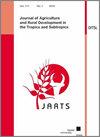评估改善印尼婆罗洲自给农业社区kacang山羊健康的务实战略
Q3 Social Sciences
Journal of Agriculture and Rural Development in the Tropics and Subtropics
Pub Date : 2019-12-02
DOI:10.17170/KOBRA-20191030733
引用次数: 1
摘要
贫困限制了小农户、自给农民预防或扭转牲畜营养不良和内寄生虫病的选择,这是资源有限的热带农业社区山羊发病率和死亡率的两个全球驱动因素。我们的第一个研究目标描述了在印度尼西亚婆罗洲农村实施三项可行且简单的畜牧业改革以改善小农户卡仓山羊群的健康后,观察到的身体状况和贫血的变化。这些变化包括常规的蹄修剪以及增加获得食物和淡水的机会。我们观察到,消瘦动物的数量从26只下降了6倍,令人印象深刻 % 至4 % 在改善蹄护理和营养14个月后,理想身体状况下的山羊几乎翻了一番,从29%增加到54%。第二个研究目标描述了在加强畜牧业计划中添加有针对性、选择性的驱虫方案14个月后观察到的群体健康变化。我们观察到贫血山羊的比例从88只显著下降 % 至74 % 开始靶向选择性群体驱虫治疗14个月后。资源有限的贫困小农自给农业社区应首先启动可行的畜牧业增强措施,以开始改善整体牛群健康,尤其是当驱虫费用或可用性延迟建立包括驱虫成分的理想计划时。本文章由计算机程序翻译,如有差异,请以英文原文为准。
Assessment of a pragmatic strategy to improve health of kacang goats in subsistence agricultural communities in Indonesian Borneo
Poverty limits options available to smallholder, subsistence farmers to prevent or reverse livestock malnutrition and endoparasitism, two of the global drivers of goat morbidity and mortality in resource-constrained, tropical, agricultural communities. Our first study objectives describe changes observed in body condition and anaemia after implementation of three feasible and simple husbandry changes to improve health of smallholder herds of kacang goats in rural, Indonesian Borneo. These changes included routine hoof trimming and increased access to food and fresh water. We observed an impressive six-fold decrease in emaciated animals from 26 % to 4 % and an almost doubling of goats in ideal body condition from 29 % to 54 % after fourteen months of improved hoof care and nutrition. The second study objective described herd health changes observed fourteen months after adding a targeted, selective, refugia deworming regimen to the enhanced husbandry program. We observed a significant decrease in proportion of anaemic goats from 88 % to 74 % fourteen months after initiating the targeted selective herd anthelmintic treatment. Impoverished, smallholder subsistence agricultural communities with limited resources should first initiate feasible husbandry enhancements to begin improving overall herd health especially when anthelmintic expense or availability delays establishing an ideal program which includes a deworming component.
求助全文
通过发布文献求助,成功后即可免费获取论文全文。
去求助
来源期刊
CiteScore
2.30
自引率
0.00%
发文量
0
审稿时长
>36 weeks
期刊介绍:
The Journal of Agriculture and Rural Development in the Tropics and Subtropics publishes papers dealing with original research and review papers in the fields of plant production, animal nutrition and animal husbandry, soil science, rural economy and farm management, forestry and forest economy, veterinary hygiene and protection against epidemics.

 求助内容:
求助内容: 应助结果提醒方式:
应助结果提醒方式:


